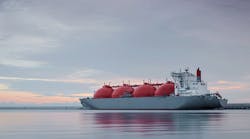Good control can reduce cost, increase efficiency of liquefied natural gas
Russia supplies 40% of the natural gas requirement of the European Union and can create chaos if it's cut off. Therefore, replacement is needed and doing it with “green” energy would take too long. One logical option is to obtain natural gas from other sources. When long distances are involved and pipelines aren't available, shipping it as liquefied natural gas (LNG) is one option. The key to optimizing the LNG production and regasification processes is good process control.
Today, the global consumption of natural gas is about 520 billion tons a year (BTy), which is about 30% of total global energy consumption. Natural gas is the largest and cleanest fossil fuel energy source, emitting 30% to 45% less CO2 than oil or coal. The total consumption of natural gas in Europe is about 80 BTy, which includes about 30 BTy imported from Russia. Meanwhile, Russia's total production is 90 BTy. The U.S. promised to help the EU by providing 2 BTy of LNG in 2022 and 6 BTy by 2030.
As we can see from the above numbers, on the one hand Europe's energy supplies are at the mercy of Russia, but on the other hand, the Russian economy would collapse if it lost the EU market. Due to this interdependence, it's obvious that some compromise will be made, and it's also obvious that the negotiating position of the EU will improve, if some of its needs are met by non-Russian sources of natural gas. This is why Germany is already building an LNG terminal at Zaporizhzhia to handle 1.0 BTy by 2023, while Estonia hopes to complete its LNG terminal by this November.
It's likely that the present energy war will be followed by others, and I hope that we will learn some lessons from this one. The main lesson is that we must speed the global conversion to free and clean green energy sources. While the present fossil fuel energy chaos temporarily increased oil and gas profits (Saudi Arabia's oil income doubled in 2022) and temporarily slowed green conversion, in the long run it will help. For example, after 40 years, the U.S. Congress finally approved the first meaningful climate legislation package.
The reason for this optimism is also because the conversion to the green (solar-hydrogen) energy economy is beginning to be driven by market forces. For example, the rise in the cost of gasoline is causing a surge in electric car sales. The 90% drop in solar energy costs caused Volvo to replace some diesel trucks with hydrogen models. Bremervörde (in Saxony) replaced diesel trains with hydrogen ones, and Hungary is considering buying 16 of them. No matter how powerful the fossil fuel industry is, once it costs less, conversion will accelerate. (I often joke that if Saudi Arabia owned the sun, the gas pumps at the service stations would already be filling up our cars with solar-hydrogen.)
LNG production and shipping
The main constituent of natural gas, methane, is some 80 times more powerful as a greenhouse gas than CO2 but it stays in the air "only" for decades, while CO2 persists for centuries. It enters the atmosphere from leaks in pipelines or from venting (flaring) the wells or from such processing steps as producing methane from natural gas. The Biden Administration initiated a Methane Emissions Reduction Action Plan and the U.S. Department of the Interior will spend $1.15 billion to clean up orphaned oil and gas wells that are still releasing it. (I discussed the satellite monitoring of methane leaks in the April issue, so I won't repeat it here.)
LNG tankers differ from traditional oil tankers in that their cargo is pressurized and held at extremely low temperatures. During the voyage, a small amount of LNG is converted into gas called boil-off gas. In newer carriers, the boil-off rates are below 0.1% of volume per day. These newer tankers carry some 25,000 tons of LNG and cost about $250 million. LNG is transported in double-hulled ships, designed to handle the low temperature, and the unloading at the receiving terminals, where it's stored and regasified.
Control and optimization
Good control can reduce the cost of LNG by increasing the efficiency of the liquefying and regassing processes. The overall efficiency of the liquefaction process requires that the cooling load among liquefying heat pumps be optimally distributed. The heat pumps move heat from lower to higher temperatures by circulating a refrigerant that takes heat from the LNG by evaporation at a low pressure in the evaporator. And, after being compressed into a high-pressure gas, it's condensed to release the heat it carries into the refrigerant circulating at the next stage.
In an optimized system, the compressor speed at each stage is manipulated by implementing a cascade loop that maintains the temperature of the stage below by controlling the pressure in the heat pump's evaporator.
When the LNG transport ship arrives at the receiving terminal, its load is usually regasified for pipeline distribution as a high-pressure gas. If the heat source of the regasification process is sea water, then the "cooling energy" (approximately 12 GW in all the LNG regasifiers globally) is often wasted because the heated water is usually just returned to the ocean. In optimized control systems, this cooling energy could be utilized for power generation, air separation, desalination and other useful purposes, which would further optimizes the overall LNG process.
About the author: Béla Lipták
Béla Lipták is an automation and safety consultant and editor of the Instrument and Automation Engineers’ Handbook (IAEH). He can be contacted at [email protected].







